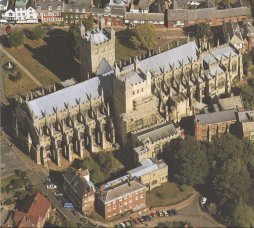 |
Exeter city |
Web Plymouth (Home) |
Cathedral Church of
Saint Peter   Web site |
Historic
Quayside Once a Roman waterway, later a 16th century port and today a city centre riverside resort, Exeter's Historic Quayside is a wonderful and popular tourist attraction. The Quayside offers a unique collection of shops, restaurants and outdoor activities which blend with the attractive 17th and 18th century warehouses and buildings to give a charming mix of past and present. Picnicking, walking, browsing, taking a boat trip |
Custom House The Custom House, constructed in 1680-81, is the earliest surviving substantial brick building in Exeter, and was used by H.M. Customs and Excise until 1989. The front was originally an open colonnade but was bricked up later. Fine ornamental plaster ceilings exist in the first floor rooms and it is hoped that these may be made available for public access in the future. |
Red Coat Guide A variety of free walking tours are available, each focusing on a different aspect of Exeter’s long and varied history. Medieval Exeter A tour around the West Quarter of the City Exeter’s City Wall Exeter is a Walled City and over 70% of the structure still stands. Dating from Roman times the City Wall and this tour incorporates 2000 years of Exeter’s history. |
High Street Exeter High Street was severely damaged in the May 1942 Blitz of Exeter in World War II. Most of the buildings in the upper part of High Street were completely destroyed, although some of the historical buildings in the lower end were spared, such as the Guildhall (one of the oldest municipal buildings in the country), St. Stephen's Church and Nos. 226/227 High Street (the restored 16/17th century buildings). |
Guildhall The Guildhall has served as the centrepiece of Exeter’s civic life for more than 800 years. A structure of outstanding architectural interest, it is not merely an ancient monument but remains a busy working building - still in regular use for a variety of civic functions and full meetings of the City Council. |
Cathedral Close St Martin's Church is of Saxon origin and was dedicated in 1065. It is one of only three churches in Devon known to preserve Saxon masonry. It was rebuilt in the 15th century in Heavitree stone; the porch was added in the 19th century. Mols Coffee House: This building was erected in 1596. When coffee drinking became fashionable in the 18th century it became a club and coffee house. In the 19th century the third storey with its Dutch gable was remodelled.The first floor oak panelled room has an elaborate frieze of shields with the arms of Devonshire families. |
The house that
moved The early 16th century timber framed house, known as the House that Moved was originally sited on No. 16 Edmund Street (on the corner of Edmund Street and Frog Street). In 1961 the house was moved to its present position at the foot of West Street to make way for the inner bypass. This was achieved by jacking the house up and lifting it onto a chassis with iron wheels. The building was guided to its new position with the aid of rails that were laid onto the road surface, into which the wheels fitted. It was then hauled, with the aid of winches, approximately 100 yards uphill to the new site. |
Old Exe Bridge The building of the medieval Exe Bridge was due largely to the efforts of Nicholas Gervaise, a wealthy merchant of the city, and his son, Walter, who was four times mayor and died in 1259. They raised the money to construct the bridge and purchased property to provide an annual income for its future maintenance. The bridge was probably started within a few years of 1200 when the river was much wider than it is today. It is the earliest surviving large stone bridge in the country. The predominant building stone is a volcanic rock known as 'trap' obtained from several local quarries in the medieval period. |